Sample Case - Sample Case, Report, and Exhibit
Anonymous Writing
In this case, comments were added to a document. Were they written by the same person who wrote the body of the document? The case was atypical because it focused on printed rather than cursive writing. Although there was not a large amount of writing, a conclusive opinion was possible. The Questioned Document is a photocopy of a government form. K1 refers to the known writing, and Q1,2 and 3 are the questioned writing.
In this case, comments were added to a document. Were they written by the same person who wrote the body of the document? The case was atypical because it focused on printed rather than cursive writing. Although there was not a large amount of writing, a conclusive opinion was possible. The Questioned Document is a photocopy of a government form. K1 refers to the known writing, and Q1,2 and 3 are the questioned writing.
Materials:
K1 - Known printed writing
Q1 - Printed note written diagonally in the upper left corner of the QD
Q2 - Printed line "Sherriff's Department" written at top center of the QD
Q3 - Printed excalmation written diagonally in the upper right corner of the QD
Question: Were Q1, 2 and 3 written by the same person who wrote the known writing?
Procedures and Observations: All of the writing in this case was examined with the unaided eye and under microscope at magnifications from 7X through 25X. Glass alignment plates were used to examine the baseline, top line and spacing of the writing. The following writing characteristics are apparent:
1. Both known and questioned writings use entirely upper case letters with the possible exception of the "I" which may not always be in the form of the capital. Although there is no dot over the I to indicate a lower case letter, the simple "stick" form of the "I" is used and it varies in height.
2. Letter spacing resembles elite or pica type in that it is non-proportional (every letter is given almost the same amount of horizontal space, regardless of its requirements). The result is open space around the "I" of "Valentines" and to a lesser extent the "I" of "Sherriff's" in the Q1 and Q2. This same spacing is seen in the words "visiting", "times" "inmates" and "special" in the known writing. Notice this letter spacing in the exhibit below. The top line is the known writing.
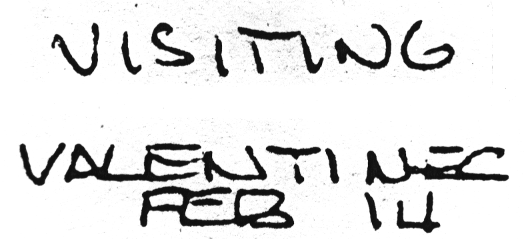
3. The baseline of Q1, Q2 and Q3 is artificially straight and appears to have been formed by holding a straightedge on the paper as a guide. Possibly this was done as a disguise factor. The bottoms of the letters "D", "B", "O", and others are complete, although flattened. Therefore, the straigntness of the baseline is not due to the bottom of the writing being clipped off with scissors in a cut and paste maneuver. The baseline of K1 is basically straight, although lacking in the precision shown in Q1-3. In the illustration (right) a glass plate containing an etched line has been placed on top of the questioned document and photographed to point out the straightness of the baseline and the flattened bottoms of the letters in Q1, 2 and 3.
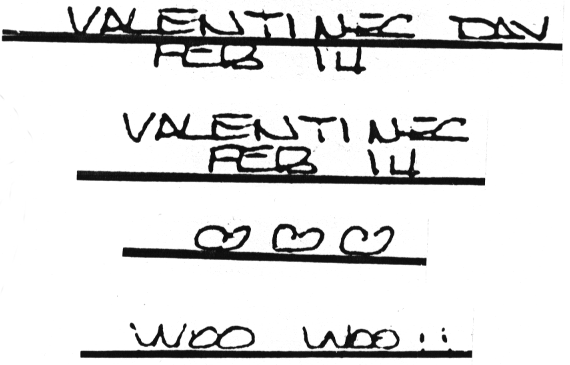
4. The top lines are also quite straight, but are formed naturally by letters that are consistent in height. This is true in K1 and in Q1- 3. This exhibit shows top and bottom line straightness in K1 and Q2.
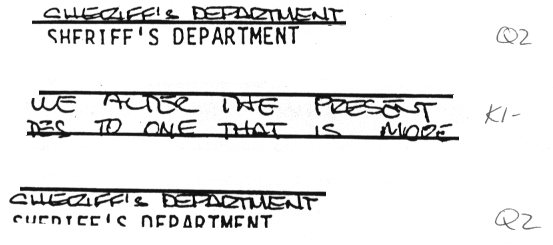
5. There is a small stroke toward the right at the end of many downward vertical strokes of letters such as "M", "N", "P", "T" and "H". This is obvious in the knowns, and even though Q1 - Q3 may have been formed against an artificial baseline, these strokes are evident in the "1" of "14" in Q1 and in the "P" and "M" of Q2. Notice this small stroke on the "M"s shown here. The top line is from Q2 and the bottom is from K.
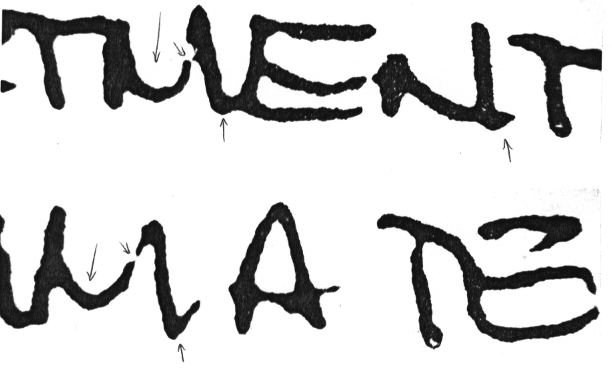
The "M"s show further evidence of identity in the shape and movement of the center curved stroke and the small hitch in the line which occurs in the same place in each writing. As further illustration of this characteristic the known and questioned writing have been optically overlaid and photographed through a comparison microscope. Color is achieved by using filters on the microcope's illuminators. The red is the questioned writing, the green is the known, and the black is where the two overlap.

6. The "O"s often join at the 9 or 10 o'clock position in both known and questioned writings. Notice this in the words "associated", "protracted", "to one", "more" and "off-peak" in the known writing and with the word "woo woo" in Q3.
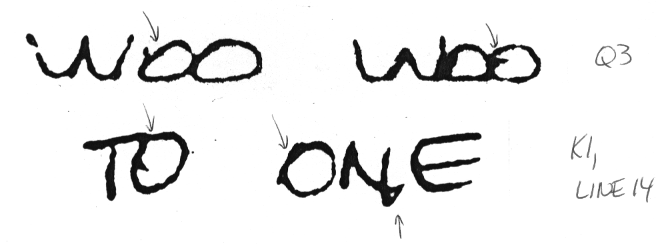
7. The cross bar of the "A" and the buckle" of the "R" are positioned close to the baseline.
8. Although the writing is hand printed, there are connections from letter to letter and places where adjacent letters touch. This is a characteristic which could be more closely examined on the original document, but it is clear enough from the copy that this characteristic exists in both the known and questioned writing.
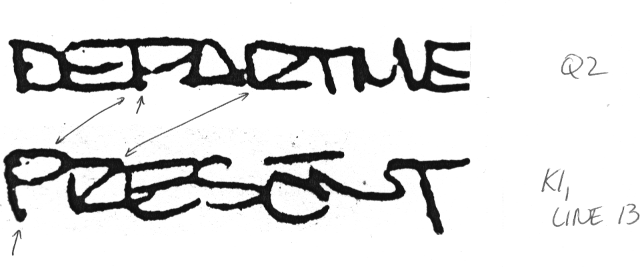
Conclusions: After a thorough examination of the questioned document, it is the examiner's opinion that the known writing (K1) and the questioned writing (Q1, Q2, and Q3) were written by the same person. All that remains is for the original to be produced to ascertain that the questioned material was actually written on that document, and not placed there mecanically.
Emily J. Will
Forensic Document Examiner
The exhibits above were produced to illustrate mock trial testimony given in this case.
Copyright © 2001-2008 Emily J. Will All Rights Reserved.
